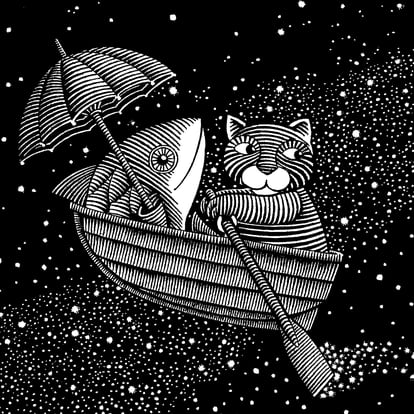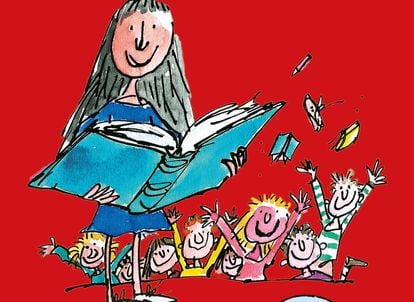The father's passion is to scam. The mother's, bingo. All much more fascinating, of course, than spending time with his daughter. There is no place for Matilda among the family's priorities. Far from it for the girl's great passion: reading. If anything, so many books alone deserve punishment. What a waste of time. Luckily, such parents are an invention of the written page. Specifically, from Roald Dahl's 1988 masterpiece. And, in the plot, they fail to sabotage Matilda's connection to the stories. However, in real life the epilogue would be different. The rise of children's and youth literature has been celebrated for some time. And studies detect a constant increase in young readers. All the experts interviewed agree on the fundamental role of home and school. That is, adults. Allies of reading? Enemies? Or maybe both at the same time. The matter is full of gray and open questions. As in the best novels.
The starting point itself can be questioned: is reading in childhood positive in itself? “It is associated with greater academic performance and success; However, we must promote and defend reading also for the simple pleasure it offers. A child who reads imagines better,” says Paula Rivera Jurado, professor in the Department of Didactics of Language and Literature at the University of Cádiz. “It increases empathy, creativity and improves social skills, in addition to reading comprehension, brain plasticity…”, adds Xavier Mínguez López, from the Department of Teaching of Language and Literature at the University of Valencia.

83.7% of the population between six and nine years old (and 78% between 10 and 14 years old) read books in their free time voluntarily, according to the recent yearbook of the SM publishing house, which detects how the rate continues to grow also among adolescents, thanks to comics among other reasons. And similar figures, even higher, were revealed yesterday Wednesday by the Barometer of Reading and Book Purchasing Habits in Spain 2023, published by the Federation of Publishers Guilds. “It is difficult to find a boy or girl who does not like stories, books, stories, whether read or invented,” reflects María Carreño López, professor of Children's Literature at the University of Granada. She herself cites some of her favorites: No one passes from here!by Isabel Minhós Martins and Bernando P. Carvalho (Takatuka); Cat and fish, of Joan Grant and Neil Curtis (Red Fox Books), Dahl himself, Pippi Longstocking either Konrad or the boy who came out of a can, by Christine Nöstlinger (Loqueleo).
But SM's report, like those published periodically by the Ministry of Culture, also shows the other side of the coin: from the age of 18, disaffection increases, which continues throughout life. So much so that the general reading percentage, in Spain, is around 65%. Growing up, a hard core maintains its love affair with books; others move on to a more sporadic romance, seduced by other entertaining lovers; and a few simply separate and forget. So such a promising sowing does not seem to bear very ripe fruit.

“Many They complain about imperative readings, since they do not find any emotional connection with them. The problem is that perhaps a reading habit has not been created during compulsory education, but rather the habit of reading to pass. If we have limited ourselves to what they send us, we will not find motivation to continue,” says Mínguez López. For this reason, some experts demand the inclusion in the curricula of works closer to the taste and interests of the class, along with the classics considered essential. And Luis Arizaleta Comajuan has coordinated a recent manifesto, signed by several National Children's and Youth Literature Awards among others, in favor of Literary Education. “When Primary and Secondary education is aimed at creating communities of readers, they are essential for generating lasting hobbies. When they focus on the reproduction of knowledge, they stifle emotion, motivation and communicative desire,” he warns by email.
Another demand, therefore, aims for reading promotion to permeate education, in every sense. “If we are talking about dinosaurs, having dinosaur books in the library; If we are going to take an excursion, have books about the place we are going to visit,” Mínguez López sums it up. “In Early Childho
od and Primary Education there is specific training on children's and youth literature. Almost always insufficient, but not absent as with higher level teaching staff. It is more linked to the voluntarism of teachers,” denounces Carreño López, who has investigated this aspect in several projects.
/cloudfront-eu-central-1.images.arcpublishing.com/prisa/EDJKGIYS6JGBNAZV24YFU7IASM.jpg)
No one doubts that a teacher or a home with a passion for reading encourages contagion. On the contrary, scholars see it as the most important pillar. But often the intention is not enough. Dedication, listening, good selection and training are repeated among the necessary ingredients for parents and teachers who want to bring books closer. Reading with them every day, being interested in their favorite works, financing their library, discussing all of this: highly recommended. Those interviewed suggest works by Pilar Mateos, María José Ferrada, Daniel Nesquens, Paula Merlán, Pep Bruno, María Teresa Andruetto, Juan Kruz Igerabide or the recently deceased Hematocrítico as guarantees of reading enthusiasm. And in most homes the lesson seems to have been learned: in 76.3% of homes with children under six years old, parents read to their children, according to the barometer published yesterday, Wednesday. However, the problem may be something else: not how or what, but when.
Families went from spending 3 hours and 23 minutes a week reading with their little ones in 2021 to 2 hours and 48 minutes in 2022, in figures on the impact of covid-19 published by the Ministry of Culture. Here is an argument in favor of teleworking. And ultimately positive news, according to Carreño López: “It shows that when we have time to share, we consider reading a recreational activity, a valid and desired pastime. Sometimes more than why we stop reading at a certain age, focusing on school or family, we should think about what rhythms of life we have.” The teacher herself adds other variables: higher income and university studies trigger the reading hobby. In other words, those who live better have more room for books. Among the rest, some will not even be interested. But perhaps there are those who want to and cannot.
The offer, of course, does not seem to be an obstacle. SM's yearbook estimates about 9,000 Children's and Young Adult Literature titles published in Spain in 2021. Albums drawn as The wall in the middle of the bookby Jon Agee (The Little Red House), and even without text, as Wave, by Suzy Lee (Barbara Fiore); fantastic sagas like Ender's Game, Divergent, The war of the witches or the eternal Harry Potter; Illustrated classics and bestsellers from TikTok. There are works for all tastes. Although some of the sources warn of a certain “dysneization” and an excess of publications more focused on a purpose – “books to” give up diapers, combat bullying, overcome a move… – than on literary value. “It is controversial to establish how to measure quality. We could say that in part it lies in the capacity of a text to sustain internal contradictions,” says Carreño López. Which, at the same time, responds to the prejudice that sometimes accompanies this sector: a certain contempt, the label of minor literature. And her older and more prestigious sister also depends on her. If a new reader is born it is decided here, in these books. Let's see who thinks it's not enough.

All the culture that goes with you awaits you here.
Subscribe
Babelia
The literary news analyzed by the best critics in our weekly newsletter
RECEIVE IT
Subscribe to continue reading
Read without limits
_
#Manual #raising #young #readers